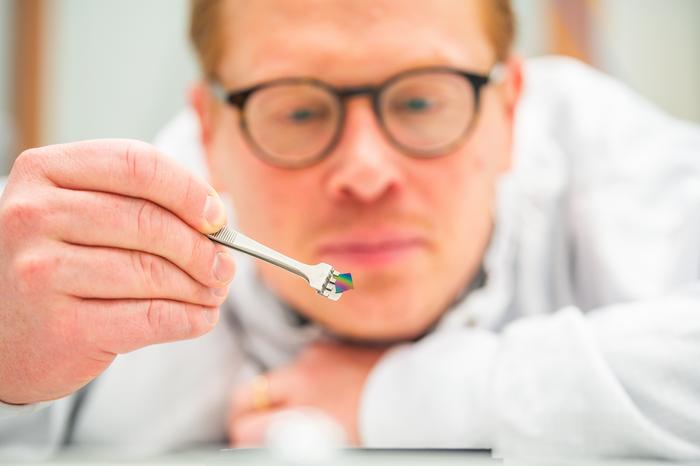
The quest for greater efficiency and miniaturization in electronic devices is driving researchers to explore innovative materials and processes in memory manufacturing. A pioneering study from Linköping University has unveiled an exciting breakthrough in the production of digital memories, showing that the incorporation of the noble gas xenon can significantly enhance the uniformity of material coatings even in the smallest of cavities. This detailed research was initiated by a team led by Professor Henrik Pedersen, whose findings have been documented in the prestigious journal Nature Communications.
Digital memory components, instrumental in everything from smartphones to sophisticated computing systems, rely on intricate layering techniques. As the demand for enhanced storage capacities escalates, manufacturers strive to fit more memory cells into increasingly compact spaces. Historically, the evolution of memory card technology has been staggering, from a mere 64 megabytes squeezing into a camera card 25 years ago to the modern-day capacity of 4 terabytes in the same size. This exponential growth exemplifies the challenges faced by engineers and scientists in pushing the boundaries of electronic storage capabilities.
At the heart of memory creation lies a complex layering process involving alternating layers of conductive and insulating materials. A formation of tiny holes is meticulously etched through these layers before being filled with conductive substances. The key to this operation lies in the precision of the coating process, where achieving even distribution of materials across these minuscule openings is critical. Unfortunately, this is easier said than done, especially given the intricate dimensions at play.
The size of the holes encountered in these memory structures can be compared to the Burj Khalifa in Dubai, which stands at an imposing 828 meters. In the context of memory production, these holes are only 100 nanometers wide and stretch a staggering 10,000 nanometers deep. The comparison starkly illustrates the engineering feat required to achieve effective filling. The challenge is not only about inserting the material; it is about ensuring uniformity throughout the depth of the holes to avoid clogging and enable optimal performance.
Professor Pedersen elucidates this predicament succinctly, highlighting the importance of obtaining a consistent material coating throughout the entire cavity. Traditional methods to tackle inconsistency often involve lowering temperatures to slow down chemical reactions, which can compromise the performance of the materials produced. The introduction of xenon gas represents a groundbreaking deviation from conventional practices, pushing the boundaries of what is possible in memory manufacturing.
What distinguishes xenon is its ability to maintain high temperature without degrading the quality of the materials used. It appears that the heavy noble gas aids in directing the smaller molecules required for coating into the deeper recesses of the holes. This insight emerged from an innovative hypothesis developed by one of Pedersen’s doctoral students, Arun Haridas Choolakkal, who linked gas movement principles to the challenges faced in memory production. Laboratory experiments conducted by the research team confirmed that this approach yielded a uniform coating at all depths of a hole, thereby resolving a long-standing issue that has plagued the industry.
To date, the research team has successfully patented their innovative technique, with intentions to take it to a commercial platform. The patent has been sold to a Finnish company dedicated to further development and global application of the technology, having already applied for patents in several countries. Pedersen believes this transition marks a significant moment that could very well establish xenon-enhanced processes as standard practice across the electronics industry.
The implications of this advancement reach far beyond just improving memory capacity. Enhanced memory technologies promise to revolutionize not only consumer electronics but also the fields of artificial intelligence, cloud computing, and high-performance computing, where vast amounts of data must be processed efficiently and swiftly. As demands for data storage continue to soar, the successful integration of such technologies will be vital for future innovations.
Further understanding of how these chemical interactions in the presence of xenon can be optimized may unlock even greater capabilities in the realm of materials science. The ongoing explorations could lead to further refinements in the manufacturing process, paving the way for even smaller, faster, and more efficient electronic devices. As researchers continue to refine this technology, the expectation is set for a new era of high-performance memory solutions.
In conclusion, the breakthrough presented by Henrik Pedersen and his team is not merely a technical enhancement; it symbolizes an important evolutionary step in electronics manufacturing. By effectively tackling the intricate challenges in memory production, they are not only transforming existing paradigms but also igniting the potential for future advancements that will reshape our technological landscape.
Subject of Research: Use of Xenon in Memory Manufacturing
Article Title: Competitive co-diffusion as a route to enhanced step coverage in chemical vapor deposition
News Publication Date: 11-Dec-2024
Web References: DOI Link
References: Nature Communications
Image Credits: Olov Planthaber
Keywords
Xenon, Digital Memory, Memory Manufacturing, Linköping University, Chemical Vapor Deposition, Material Coating, Electronic Devices, High-Performance Memory, Technology Innovation.
Tags: advanced digital memory technologieschallenges in memory card capacityenhancing electronic storage capabilitiesevolution of digital storage technologyinnovative materials for memory storagelayering techniques in memory creationLinköping University researchminiaturization in electronic devicesnoble gases in electronicsProfessor Henrik Pedersen research findingsuniformity in material coatingsxenon in memory manufacturing





